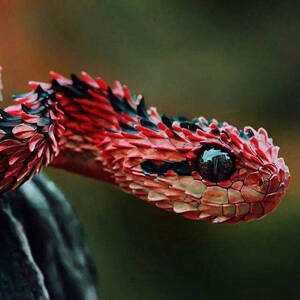Phrynocephalus mystaceus
IUCN
LCBasic Information
Scientific classification
- name:Phrynocephalus mystaceus
- Scientific Name:Phrynocephalus mystaceus,Toad-headed Agama
- Outline:Squamata
- Family:Iguanidae S.Lizard
Vital signs
- length:5-9cm
- Weight:No verification information
- lifetime:About 12 years
Feature
The largest species of lizard
Distribution and Habitat
The big-eared sand lizard is distributed in southern Russia in the northwest of its distribution range (Dagestan, Kalmykia, Astrakhan region, Stavropolsky region and eastern Chechnya), through Kazakhstan to northwestern China (Ili Basin in northwestern Xinjiang); in the south of its distribution range, it occurs in the central Iranian plateau, through Afghanistan, Turkmenistan, Tajikistan and Uzbekistan (and neighboring Kyrgyzstan). In addition, it is also distributed in Ukraine, Belarus and Turkey.
The big-eared sand lizard lives in semi-fixed sand dunes, often digging holes under sparse small bushes. In China, the big-eared sand lizard is only found in Huocheng, in the Ili River Basin of Xinjiang, and in the range of 45 meters below sea level to about 1000 meters above sea level.
Appearance
Adults are large, with a head-body length of 56-89 mm and a tail length of 55-90 mm. The head is large, with a width greater than its length, and a slightly concave space between the eyes; the snout is round and wide, with the front end almost perpendicular to the upper whiskers, and the lower collar extends slightly beyond the upper collar; the nostrils are large and face forward and upward, with 1-3 internasal scales; 3 nasal scales, and the inner edge of the upper nasal scales is connected to a vertical row of internasal scales. The frontal scales on the back of the head are the largest, followed by the interocular and parietal scales, and the supraorbital scales are the smallest. The scales are often arranged in a ring with the parietal scales as the center, and the scale ends are protruding. There are 3-4 cheek scales between the posterior nasal scales and the anterior scales. There are 8-11 upper ciliary scales, and the front 5-6 are long and flat, arranged in a shingle-like mann
Details
The big-eared sand lizard is called Toad-headed Agama in English, and there are 2 subspecies.

The big-eared sand lizard runs very fast, and when it encounters danger, it quickly burrows into the sand dunes and disappears. When being chased, it often keeps its body swaying close to the ground, digging rapidly to bury itself in the sand. Sometimes it props up its limbs, raises its front body, and lifts its tail on its back, sometimes curling and sometimes loosening. The ear-shaped skin wrinkles of the big-eared sand lizard have the function of assisting in attack and predation. When it is angry, attacking or preparing to escape, the skin folds open, revealing the flesh-red "big ears", showing a fierce posture, and flapping them constantly, making a "whooshing" sound to intimidate the opponent. The tunnel is straight and long, up to 70-80 cm, but it is shallow from the ground, with a large entrance, more than 30 mm wide, and the end of the hole does not expand.
The main food of the big-eared sand lizard includes ants, spiders, locusts, coleoptera insects and their larvae, etc. In addition, small plant fragments are found in the stomach.
The big-eared sand lizard is an oviparous animal. The mating and breeding period is from May to June. The number of eggs is as high as 3-5. It lays eggs once a year, and most of them are 3-4 eggs. Only a few large sand lizards occasionally lay 5 eggs. The egg shell is soft and translucent leathery. The female lizard has finished laying eggs in July and the breeding period ends. The young lizards hatch in August.
In Turkmenistan and Kazakhstan, the big-eared sand lizard is a common species in sandy deserts. According to statistics, there are 18 big-eared sand lizards per 2 square kilometers in Turkmenistan and 64 big-eared sand lizards per hectare in Kazakhstan. It is reported that big-eared sand lizards exist in large numbers in the deserts of northern Afghanistan. In Tajikistan, the densities of the big-eared sand lizard are very low, 1-2 individuals per square kilometer, and it is threatened with decline in the country due to habitat loss. According to a 2010 survey, the density in the Tanzil Kum region of Uzbekistan was 2-8 individuals per square kilometer. A 2011 survey of the Yamankum Sands found an average of 6 individuals per square kilometer in July. In China, the big-eared sand lizard is a rare species and its numbers are declining (2018)
The big-eared sand lizard is threatened in its range by dune stabilization and conversion of dune habitats to agricultural land (through irrigation), mining (sand mining), and urban areas. In the European part of its range, the reduction of livestock grazing has led to more lush dune vegetation, eliminating suitable habitat for the species. The big-eared sand lizard is also subject to the international pet trade, and collection for the pet trade can have a large, but localized impact on the species.
In China, the big-eared sand lizard is affected by urban construction, desert tourism development, human activities, and huge pet demand.
Listed in the "National List of Terrestrial Wildlife with Important Economic and Scientific Research Value" issued by the State Forestry Administration of China on August 1, 2000.
Listed in the first level of the "List of National Key Protected Wildlife in China"
Protect wild animals and eliminate game.
Maintaining ecological balance is everyone's responsibility!








